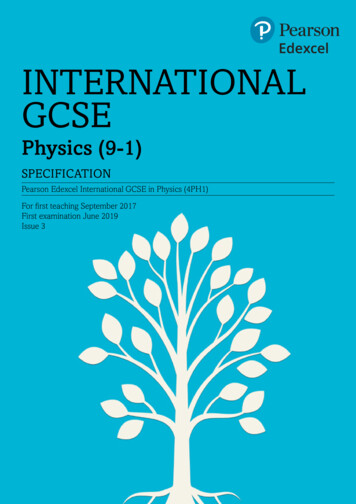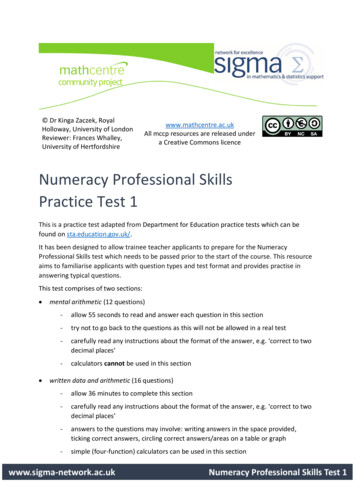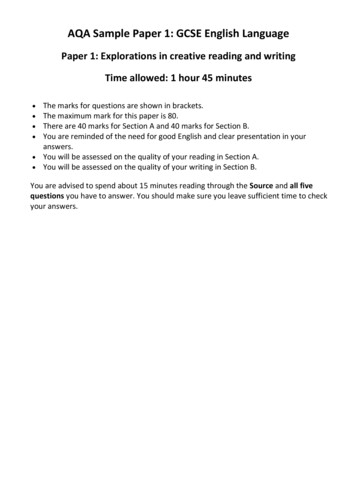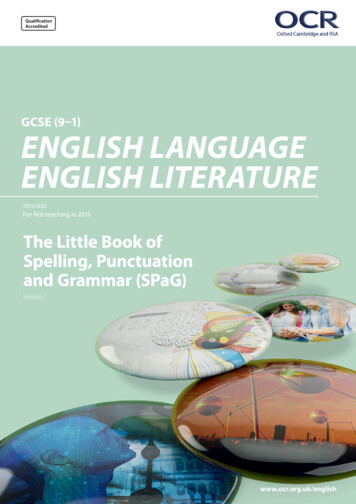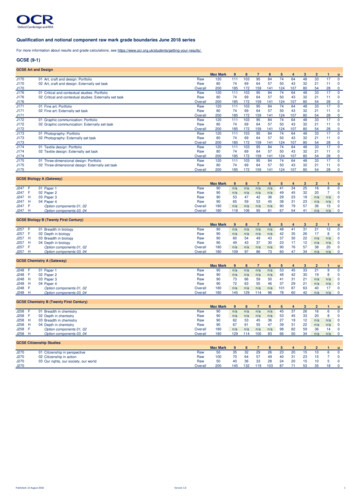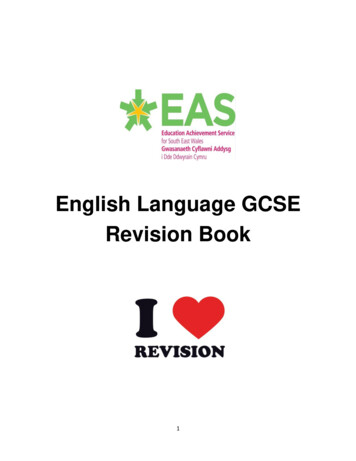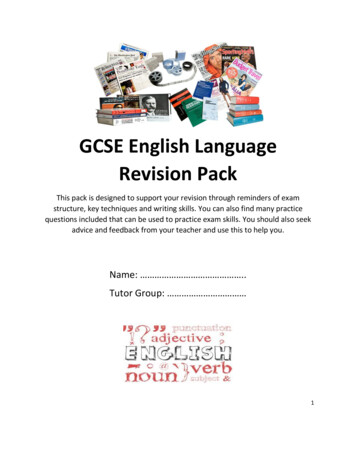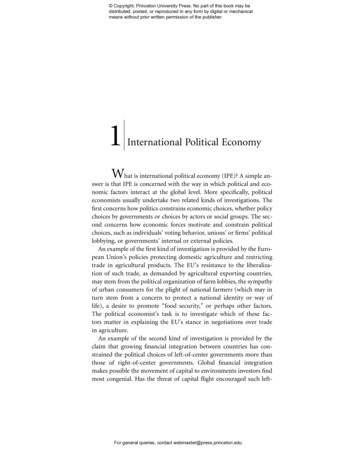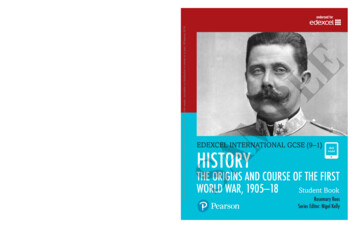
Transcription
Rosemary ReesSeries Editor: Nigel KellyPearson Edexcel International GCSE (9–1) History: The Origins and Course of the FirstWorld War, 1905–18 provides comprehensive coverage of the specification and isdesigned to supply students with the best preparation possible for the examination:For Pearson Edexcel International GCSE History specification (4HI1) for first teaching 2017.www.pearsonglobalschools.comStudent BookWritten by a highly experienced History authorContent is mapped to the specification to provide comprehensive coverageLearning is embedded with differentiated exercises and exam practice throughoutSignposted transferable skillsTrack progress with the Pearson Progression ScaleReviewed by a language specialist to ensure the book is written in a clear andaccessible styleGlossary of key History terminologyeBook includedOnline Teacher Resource Pack (ISBN 9780435191290) also available, providingfurther planning, teaching and assessment supportEDEXCEL INTERNATIONAL GCSE (9 –1)HISTORYSA HISTORY THE FIRST WORLD WAR, 1905—18 EEDEXCEL INTERNATIONAL GCSE (9 –1)Student BookPLTHE ORIGINS AND COURSE OF THEFIRST WORLD WAR, 1905–18MHISTORYUncorrected proof, all content subject to change at publisher discretion. Not for resale, circulation or distribution in whole or in part. Pearson 2018EDEXCEL INTERNATIONAL GCSE (9 –1)eBookincludedTHE ORIGINS AND COURSE OF THE FIRSTWORLD WAR, 1905–18Student BookRosemary ReesSeries Editor: Nigel Kelly
SAMUncorrected proof, all content subject to change at publisher discretion. Not for resale, circulation or distribution in whole or in part. Pearson 2018THE ORIGINS AND COURSE OFTHE FIRST WORLD WAR, 1905–18Student BookRosemary ReesSeries Editor: Nigel KellyHISTORYEPLEDEXCEL INTERNATIONAL GCSE (9 –1)
www.pearsonglobalschools.comTextExtract on page 6 from The Times, April 1914, The Times/NewsSyndication; Extract on page 29 from The First World war An IllustratedHistory by A.J.P. Taylor, copyright 1963 by George Rainbird Ltd, renewed 1991. Used by permission of G. P. Putnam’s and Sons, animprint of Penguin Publishing Group, a division of Penguin Random HouseLLC. All and rights reserved. No amendment should be made to the textwithout the written permission of David Higham Associates Limited;Extract on page 42 Approximately ninety-four (94) words from DEATH’SMEN: SOLDIERS OF THE GREAT WAR by Denis Winter (Penguin Books,2014). Copyright Denis Winter, 1978.; Extract on page 50 from WarMemoirs Volume l, Oldhams Press Limited, London (David Lloyd George)Universal Library, Beaverbrook Foundation (CIO).; Extract on page 57from Modern World History for SEG Syllabus B, David Ferriby, DavidHansom, Steven Waugh, Pearson Education Limited; Extract on page72 from The Imperial War Museum Book of The First World War, IWM(1991) 159-167; 008; Extract on page 80 from army.mod.uk, ir-douglas-haig, Crown copyright. Contains publicsector information licensed under the Open Government Licence (OGL)v3.0. ment-licence/version/3/; 008; Extract on page 84 From Twentieth Century Battlefields byPeter and Dan Snow published by BBC Books. Reproduced by permissionof The Random House Group Ltd 2008; Extract on page 85 from GeneralJack’s Diary, 1914-1918 by J.L Jack (edited by John Terraine). The OrionPublishing Group, reprinted by permission of Peters Fraser & Dunlop (www.petersfraserdunlop.com) on behalf of the Estate of J L Jack.Copies of official specifications for all Pearson qualifications may befound on the website: https://qualifications.pearson.comText Pearson Education Limited 2017Edited by Brigid James and Juliet GardnerDesigned by Cobalt id and Pearson Education LimitedTypeset and illustrated by Phoenix Photosetting Ltd, Chatham, KentOriginal illustrations Pearson Education Limited 2017Cover design by Pearson Education LimitedPicture research by Andreas SchindlerCover photo/illustration Mary Evans Picture Library: SZ Photo / ScherlInside front cover Shutterstock.com: Dmitry LobanovFirst published 201719 18 1710 9 8 7 6 5 4 3 2 1PLThe rights of Rosemary Rees to be identified as author of this work havebeen asserted by her in accordance with the Copyright, Designs andPatents Act 1988.British Library Cataloguing in Publication DataA catalogue record for this book is available from the British LibraryISBN 978 0 435 18542 8MCopyright noticeAll rights reserved. No part of this publication may be reproduced inany form or by any means (including photocopying or storing it in anymedium by electronic means and whether or not transiently or incidentallyto some other use of this publication) without the written permission ofthe copyright owner, except in accordance with the provisions of theCopyright, Designs and Patents Act 1988 or under the terms of a licenceissued by the Copyright Licensing Agency, Barnards Inn, 86 Fetter Lane,London EC4A 1EN (www.cla.co.uk). Applications for the copyrightowner’s written permission should be addressed to the publisher.Printed in Slovakia by NeografiaAcknowledgementsThe publisher would like to thank the following for their kind permissionto reproduce their photographs:(Key: b-bottom; c-centre; l-left; r-right; t-top)Alamy Stock Photo: Archive Images 10cl, 68tr, Chronicle 23cr, 48tr,79br, 84c, Everett Collection Historical 33bl, 83cr, GL Archive 43br,IanDagnall Computing 52tr, INTERFOTO 45cr, John Frost Newspapers68br, Lebrecht Music and Arts Photo Library 47c, Mary Evans PictureLibrary 26c, Niday Picture Library 62br, Photo 12 5br, Photo Researchers,Inc 41cr, 51br, 66t, ivcr, Pictorial Press Ltd 46br, World History Archive71br The Army Medical Services Museum: 42tl Australian WarMemorial: 86c Bridgeman Art Library Ltd: ‘What is Wanted in DarkestAfrica is the Electric Light’, advertisement for Woodhouse & Rawson ltd(litho) (b/w photo), English School, (19th century) / Private Collection11tl Getty Images: DeAgostini 30tr, Hulton Archive 21br, Imagno / HultonArchive 2, Imperial War Museum 49br, Mansell / Time & Life Pictures 59,Popperfoto 41bl, Robert Hunt Library / Windmill books / UIG 77, ullsteinbild 19, 63b, Universal History Archive 36 TopFoto: 6cr, 13cr, StapletonHistorical Collection / HIP 89br, ullsteinbild 88brAll other images Pearson EducationEWe are grateful to the following for permission to reproduce copyrightmaterial:SAUncorrected proof, all content subject to change at publisher discretion. Not for resale, circulation or distribution in whole or in part. Pearson 2018Published by Pearson Education Limited, 80 Strand, London,WC2R 0RL.Select glossary terms have been taken from The Longman Dictionary ofContemporary English Online.DisclaimerAll maps in this book are drawn to support the key learning points. Theyare illustrative in style and are not exact representations.Endorsement StatementIn order to ensure that this resource offers high-quality support for theassociated Pearson qualification, it has been through a review processby the awarding body. This process confirms that this resource fullycovers the teaching and learning content of the specification or part ofa specification at which it is aimed. It also confirms that it demonstratesan appropriate balance between the development of subject skills,knowledge and understanding, in addition to preparation for assessment.Endorsement does not cover any guidance on assessment activitiesor processes (e.g. practice questions or advice on how to answerassessment questions), included in the resource nor does it prescribeany particular approach to the teaching or delivery of a related course.While the publishers have made every attempt to ensure that advice onthe qualification and its assessment is accurate, the official specificationand associated assessment guidance materials are the only authoritativesource of information and should always be referred to for definitiveguidance.Pearson examiners have not contributed to any sections in this resourcerelevant to examination papers for which they have responsibility.Examiners will not use endorsed resources as a source of material forany assessment set by Pearson. Endorsement of a resource does notmean that the resource is required to achieve this Pearson qualification,nor does it mean that it is the only suitable material available to supportthe qualification, and any resource lists produced by the awarding bodyshall include this and other appropriate resources.
IVTIMELINE VI1. THE ALLIANCE SYSTEM AND INTERNATIONAL RIVALRY,1905–14 2EABOUT THIS BOOK 193. THE SCHLIEFFEN PLAN AND DEADLOCK ON THE WESTERNFRONT 364. THE WAR AT SEA AND GALLIPOLI 595. THE DEFEAT OF GERMANY 77GLOSSARY 94MINDEX PL2. THE GROWTH OF TENSION IN EUROPE, 1905–14 SAUncorrected proof, all content subject to change at publisher discretion. Not for resale, circulation or distribution in whole or in part. Pearson 2018CONTENTS96iii
ABOUT THIS BOOKABOUT THIS BOOKThis book is written for students following the Edexcel International GCSE (9–1) History specification and covers one unitof the course. This unit is The Origins and Course of the First World War, 1905–18, one of the Historical Investigations.EThe History course has been structured so that teaching and learning can take place in any order, both in the classroomand in any independent learning. The book contains five chapters which match the five areas of content in thespecification: The alliance system and international rivalry, 1905–14 The growth of tension in Europe, 1905–14 The Schlieffen Plan and deadlock on the Western Front The war at sea and Gallipoli The defeat of GermanyPLEach chapter is split into multiple sections to break down content into manageable chunks and to ensure full coverageof the specification.Each chapter features a mix of learning and activities. Sources are embedded throughout to develop your understandingand exam-style questions help you to put learning into practice. Recap pages at the end of each chapter summarise keyinformation and let you check your understanding. Exam guidance pages help you prepare confidently for the exam.TimelineVisual representationof events to clarifythe order in whichthey happened.20THE GROWTH OF TENSIONLearning objectivesEach section starts with a list of whatyou will learn in it. They are carefullytailored to address key assessmentobjectives central to the course.THE FIRST WORLD WAR, 1905–18SourcePhotos, cartoons and text sources are usedto explain events and show you what peoplefrom the period said, thought or created,helping you to build your understanding.DEADLOCK ON THE WESTERN FRONTM Understand the reasons why Germany intervened in North Africa Understand the impact of German intervention on its relations with France Understand the significance of the Moroccan crises for relations between the Great Powers.1905 Visit of Kaiser Wilhelm IIMay 1911 France and Spain sendtroops to Fez, capital of Moroccoto Tangier1904 Britain and Franceagree to a French mandateover MoroccoNovember 1911 Treaty of FezJuly 1911 Germany sends a gunboat to Agadir1906 Algeciras ConferenceFrance sends more troops to MoroccoGermany hit by a financial crisisSAIn 1905, Morocco was one of the few African states not occupied by aEuropean power. But its ruler, Sultan Abdul Aziz, was facing challenges to hisrule. The Berber tribes who lived in the Atlas Mountains were fighting for theirindependence. By 1903 Fez, the capital of Morocco, was under attack andSultan Aziz had lost control of most of the country as thousands of Moroccanssupported the rebel Berbers. Figure 2.1 Morocco in ierAlgecirasFezTHE FIRST MOROCCANCRISIS, 1905–6KEY TERMmandate the authority to make decisionsKEY TERMScensor to remove any information thatwas not acceptable to the authoritiesFlanders an area of northern Franceand Belgium; the principal town wasYpresSoldiers never knew when they would be able to get home, and often it wasover a year before they saw their family and friends again. Soldiers in the frontline were only allowed to send field postcards (see Source B), but those furtheraway from the fighting could write letters home. These letters were usuallycensored by the authorities to ensure that nothing was accidentally givenaway that would help the enemy. Families and organisations, like the BritishRed Cross and the German Deutsches Rotes Kreuz, sent parcels of ‘luxuries’to the troops – razor blades and soap, cigarettes, cake and chocolate, handknitted socks and gloves.EXTEND YOUR KNOWLEDGETUNISIATHE WIPERS TIMESMOROCCOAgadirA working party of British soldiers on theSomme, July 1916.British field postcard.LYkm41SOURCE ASOURCE B400THE FIRST WORLD WAR, 1905–18Although the trenches were a terrifying place during battle, most of the timevery little was happening. So boredom was one of the most difficult aspectsof day-time trench life for many soldiers. The day often involved routine worksuch as sentry duty, trench repair or bringing supplies from reserves trenches.In the front-line trenches, night was a time of silence and fear. Selected groupsof men were sent on night patrol, crawling through the mud, filth, shell-holesand decaying bodies of no-man’s-land to spot enemy activity. Sometimesthere was a night attack on enemy trenches, taking prisoners and gaininginformation about what the other side was planning.2.1 THE MOROCCAN CRISES 1905–6 AND 1911LEARNING OBJECTIVESITAUncorrected proof, all content subject to change at publisher discretion. Not for resale, circulation or distribution in whole or in part. Pearson 2018ivALGERIALIBYAFrance had been involved in Morocco since 1871, when the loss of AlsaceLorraine meant that the French were trading in Morocco for minerals. (Seepage 11.) The weakness of the country worried French politicians and in 1900and 1901 they had made secret agreements with Italy that Morocco shouldcome under French control. In April 1904, France and Britain agreed thatFrance would have a mandate over Morocco and, in return, France would giveKey termUseful words and phrases are colour coded within the maintext and picked out in the margin with concise and simpledefinitions. These help understanding of key subject termsand support students whose first language is not English.During a pause in the fighting around the French town of Ypres, a group ofBritish soldiers found an old printing press. They got it working and produced amagazine called the ‘Wipers Times’. (‘Wipers’ was the way most British soldierspronounced ‘Ypres’.) The magazine joked about British officers through cartoons,advertisements, letters and announcements, as well as articles that made fun oftheir living conditions and battle plans. It was very popular.DIRT AND DISEASEIn order to fight efficiently, men must be kept fit and well. Trenches were nothealthy places: troops had to face cold, mud and the side effects of sleepingrough. Dominating all efforts at remaining healthy was mud. The ground inFlanders easily turned into a sea of mud. Men and horses drowned in it.Extend your knowledgeInteresting facts to encourage wider thought andstimulate discussion. They are closely related tokey issues and allow you to add depth to yourknowledge and answers.
ActivityEach chapter includesactivities to help checkand embed knowledgeand understanding.Exam-style questionQuestions tailored tothe Pearson Edexcelspecification to allow forpractice and developmentof exam writing technique.They also allow forpractice responding to thecommand words used inthe exams.DEADLOCK ON THE WESTERN FRONTRecapAt the end of each chapter, you will finda page designed to help you consolidateand reflect on the chapter as a whole.THE FIRST WORLD WAR, 1905–185354PAPERDEADLOCK2 ON THE WESTERN FRONTAtlantic the USA had declared war on Germany. Men and machines had beenarriving on the Western Front within weeks of the American declaration of war.But would enough arrive in time to ensure Allied victory, or would Germanyand its allies win? The year 1918 was to be a critical one.123456789101 List the reasons why the battle of the Somme resulted in such a hugeloss of life. Is any one reason more important than the others? Explainyour answer.2 It is November 1917. General Haig is planning to attack the Germans atPasschendaele. What advice do you give him?3 Which side won the battle of the Somme and which side the battle ofPasschendaele?E(a) Study Sources L and M. How far does Source M support the evidence ofSource L about Haig’s lack of ability to plan a campaign?(8 marks)AO3SKILLS(b) Study Extract A. It suggests that Haig was a good general. How far do youagree with this interpretation? Use Sources L and M, Extract A and your ownknowledge to explain your answer.(16 marks)AO4CRITICAL THINKING, REASONING,DECISION MAKING, ADAPTIVELEARNING, CREATIVITY, INNOVATIONSUMMARY HINTDon’t forget that in question (b) you are being asked whether you agree with theinterpretation, not just whether the sources and interpretation do. So you must bringyour own knowledge into the answer.ACTIVITYThe Schlieffen Plan failed and Germany had to fight France and Russia at the same time.Both sides dug trenches along the Western Front to defend themselves and stop the other side advancing.The routine of trench life could become boring when neither side was attacking.No-man’s-land, between enemy trenches, had to be crossed during an attack. It was full of shell holes androtting bodies.Seriously wounded soldiers were sent to Casualty Clearing Stations or back home.Many soldiers suffered from shell-shock.Mud, dirt and disease were common problems for all soldiers.Both sides used artillery barrages to destroy barbed wire barricades and front line trenches.Aircraft were used for observation and later for fighting.Machine guns were used by both sides and quickly mowed down lines of advancing troops.Poison gas was used by both sides and could blind and suffocate.Tanks were first used by the British in November 1917 and by the Germans in March 1918.The battle of the Somme lasted for four months; nothing was gained and over a million men were killed orwounded.The Allies gained 800 m of mud during the battle of Passchendaele (1917) when nearly half a million men werekilled and wounded.General Haig was blamed by many for failures on the Western Front.PLHintAll exam-style questionsare accompanied by a hintto help you get started onan answer.CHALLENGEC1 Explain how disease became a problem in the trenches.C2 How important were tanks as a weapon of war?C3 To what extent was Haig’s leadership responsible for the huge number of casualties in (a) the battle of theSomme and (b) the battle of Passchendaele?EXAM-STYLE QUESTIONSANALYSIS, ADAPTIVELEARNING, CREATIVITYWhat does BEF stand for?Which battle was fought close to Paris, and when?What was a British field postcard?What is the name of the psychological condition that made soldiers shake and moan in fear?Name one type of gas used on the Western Front.What was a barrage?Name the town the French armies were determined to defend at all costs.On what date did the battle of the Somme start?Who was David Lloyd George?When did the battle of Passchendaele begin?STRENGTHENS1 Why was there stalemate on the Western Front by December 1914?S2 Give two examples of problems faced by soldiers living in trenches.S3 What was the purpose of a bombardment?Haig was not deflected from his purpose. Only a man of outstanding honestyand great strength of character would have remained and done what he did.He continued to follow the strategy he believed to be right. The events of 1918proved it was right. It is doubtful whether anyone else could have done it sowell.AO3 1 Draw up a timeline of battles on the Western Front. Use the timeline to write a paragraph explaining why, afterthree years of fighting, neither side had won.2 Look at Figure 3.6. Is there anything you think should be added to the information that surrounds the photographof General Haig? Or is there anything you think should be written differently? For example, you might want tofocus more on the numbers of dead and wounded. Sketch out a picture of Haig and add the information aroundit that you think should be there. Don’t just copy out the information provided in Figure 3.6.3 Draw up two columns. Head one ‘Haig the good general’ and the other ‘Haig the butcher of men’. Find evidencefrom this section that will help you fill each column. Now use the evidence you have collected to write an answerto the question ‘Was Haig a good general?’. MCheckpointCheckpoints help you to check and reflect on your learning. The Strengthensection helps you to consolidate knowledge and understanding, and checkthat you have grasped the basic ideas and skills. The Challenge questionspush you to go beyond just understanding the information, and intoevaluation and analysis of what you have studied.Exam guidanceAt the end of each chapter, you will find two pagesdesigned to help you better understand the exam questionsand how to answer them. Each exam guidance sectionfocuses on a particular question type that you will find inthe exam, allowing you to approach them with confidence.92PAPERTHE DEFEAT2OF GERMANYLITERARYTHE FIRSTHERITAGEWORLD WAR, 1905–18EXAM GUIDANCE: PART (A) QUESTIONSQuestion to be answered: Describe two features of either US troopactivity on the Western Front (1917-18) or the assassination of theArchduke Franz Ferdinand in 1914.(6 marks)AO112Analysis Question 1: What is the question type testing?In this question, you have to demonstrate that you have knowledge andunderstanding of the key features and characteristics of the period studied.In this particular case, it is knowledge and understanding of either US troopactivity on the Western Front (1917–18) or the assassination of the Archduke.In this example, we are going to presume that the candidate has answered onUS troop movement.Analysis Question 2: What do I have to do to answer the question well?Obviously you have to choose one of the two options and write about it! Butit isn’t just a case of writing everything you know. You have to write about twofeatures. What are features? They are ‘aspects’ or ‘characteristics’. We mighteven say that if you were allowed to put sub-headings in your answers, bothfeatures would be the sub-headings you would put.So, in this case, you might write about the cause as a feature by saying ‘UStroop activity on the Western Front was because of ’ or the details of theactions of the US troops by saying ‘One of the actions of the US troops on theWestern front was ’ or the effects of US troop activity as a feature by saying‘The US troops played an important part ’.3LITERARYTHE FIRSTHERITAGEWORLD WAR, 1905–18CHECKPOINTFrom a book by a modern historian, writing about General Haig.SKILLSRecall quizThis quick quiz is ideal forchecking your knowledgeor for revision.RECALL QUIZEXTRACT ASkillsRelevant exam questionshave been assigned thekey skills which you willgain from undertakingthem, allowing for astrong focus on particularacademic qualities. Thesetransferable skills arehighly valued in furtherstudy and the workplace.vRECAPACTIVITYSAUncorrected proof, all content subject to change at publisher discretion. Not for resale, circulation or distribution in whole or in part. Pearson 2018ABOUT THIS BOOKAnalysis Question 3: Are there any techniques I can use to make it veryclear that I am doing what is needed to be successful?This is a 6-mark question and you need to make sure you leave enough timeto answer the other two questions fully (they are worth 24 marks in total).Therefore, you need to get straight into writing your answer. The question asksfor two features, so it’s a good idea to write two paragraphs and to begin eachparagraph with phrases like ‘One feature was ’, ‘Another feature was ’. Youwill get a mark for each feature you identify and up to 2 marks for giving detailto support it. This gives the maximum of 6 marks.You have to demonstrate knowledge, so make sure you back up yourparagraphs with as much detailed knowledge as you have. But remember,you are not writing an essay here. You are providing enough detail to pick up2 extra marks on each feature you have identified.Student answersExemplar student answers are used to show whatan answer to the exam question may look like.There are often two levels of answers so you cansee what you need to do to write better responses.Advice on answering thequestionThree key questions aboutthe exam question areanswered here in order toexplain what the questionis testing and what youneed to do to succeed inthe exam.1stPearson ProgressionSample student answershave been given a PearsonStep from 1 to 12. This tellsyou how well the responsehas met the criteria in thePearson Progression Map.CommentaryFeedback on the quality ofthe answer is provided tohelp you understand theirstrengths and weaknessesand show how they canbe improved.SummaryThe main points of each chapterare summarised in a series ofbullet points. These are great forembedding core knowledge andhandy for revision.PAPERTHEDEFEAT2OF GERMANY1st2ndLITERARYTHE FIRSTHERITAGEWORLD WAR, he US troops fought with British troops in the battle of the Marne in July 1918.They also built railways in France. They played an important part in the defeat ofGermany.What are the strengths and weaknesses of Answer A?It doesn’t have many strengths. It identifies two features (that US troops foughtin the battle of the Marne in 1918, and that they built railways in France) butthe final sentence (that they played an important part in the defeat of Germany)is more of an assertion than detailed support. This answer is not going to getmore than 2 marks. It needs much more One feature of US troop activity on the Western Front was that they worked withthe Allied troops in helping to defeat Germany. Two divisions of Americans joined theAllies in the second battle of the Marne in July 1918 that prevented the Germanstaking Paris during the Ludendorff Offensive. The following month they joined theBritish Third Army in the defeat of the Germans at the battle of Albert.Another feature of US troop activity on the Western Front was the work they didon developing the French transport system. They enlarged French ports so that moretroops and supplies could be landed in France; they built over 1,600 km of railwaylines and laid over 16,000 km of telephone and telegraph cables.What are the strengths and weaknesses of Answer B?This is an excellent answer. It identifies two features (working with Allied forcesand developing the French transport system). It clearly shows there are twofeatures and provides detailed support for them both. There is no need to lookfor ways to improve this answer, you should just learn from it.Challenge a friendUse the Student Book to set a part (a) question for a friend. You could use theother option for the question above – two features of the assassination of theArchduke Franz Ferdinand. Then look at the answer. Does it do the followingthings? Identify two features Make it clear two features are being covered Provide 3-4 lines of detailed information to support the feature.If it does, you can tell your friend that the answer is very good!93
TIMELINETIMELINE — THE ORIGINS AND COURSE OF THE FIRST WORLD WAR, 1905–18190819051906British HMS DreadnoughtlaunchedAlgeciras e Ententeformed (Britain,France and Russia)1911Germany sendsgunboat to AgadirE‘Young Turk’ revolutionin TurkeyAustria annexesBosnia-HerzegovinaRussia loses war against JapanSchlieffen Plan devisedGerman Kaiser visits Tangier1906Earthquake in SanFrancisco1908First Model T Ford soldSAUncorrected proof, all content subject to change at publisher discretion. Not for resale, circulation or distribution in whole or in part. Pearson 2018vi1905Revolution in RussiaTIMELINE – WORLD1909Plastic inventedFirst time fingerprints usedto solve murder case1911Revolution in ChinaMona Lisa stolenfrom Louvre in Paris
19181912First BalkanWar1913SecondBalkan WarBattle of Dogger BankGermany announcesunrestricted submarinewarfareGerman U-boatsinks passenger linerLusitaniaLudendorff Offensive2nd Battle of the Marne stops German advanceInfluenza virus hits EuropeBattle of AmiensAllies break through the Hindenburg LineMutiny in German navyGerman Kaiser flees to HollandArmistice signed19171914USA declares war on GermanyRussia signs Treaty of Brest LitovskBattle of PasschendaeleBattle of Cambrai19141916Battle of VerdunBattle of JutlandBattle of the Somme1915M1913PLMurder of Archduke FranzFerdinand in SarajevoOutbreak of warBattle of MonsBattle of Heligoland BightBattle of the Marne1912E19151916191719181916Easter Rising in DublinSAUncorrected proof, all content subject to change at publisher discretion. Not for resale, circulation or distribution in whole or in part. Pearson 2018TIMELINE1912Titanic sinks1917Balfour DeclarationTwo revolutions in Russia1918Russian royal family murderedvii
THE ALLIANCE SYSTEMTHE FIRST WORLD WAR, 1905–18MPLE1. THE ALLIANCESYSTEM ANDINTERNATIONALRIVALRY, 1905–14LEARNING OBJECTIVES Understand the reasons why the Triple Entente was formedSAUncorrected proof, all content subject to change at publisher discretion. Not for resale, circulation or distribution in whole or in part. Pearson 20182 Understand the significance of imperial and economic rivalry in creating tension between Britain and Germany Understand the ways in which an arms race increased tension between the two alliance systems.In the years after 1905, a mixture of suspicion and fear, ambition and rivalry created enormoustension in Europe. The largest and strongest countries had made alliances with each other sothat Europe was divided into two powerful groups. Germany, Austria-Hungary and I
Pearson Edexcel International GCSE (9–1) History: The Origins and Course of the First World War, 1905–18 provides comprehensive coverage of the specification and is designed to supply students with the best
